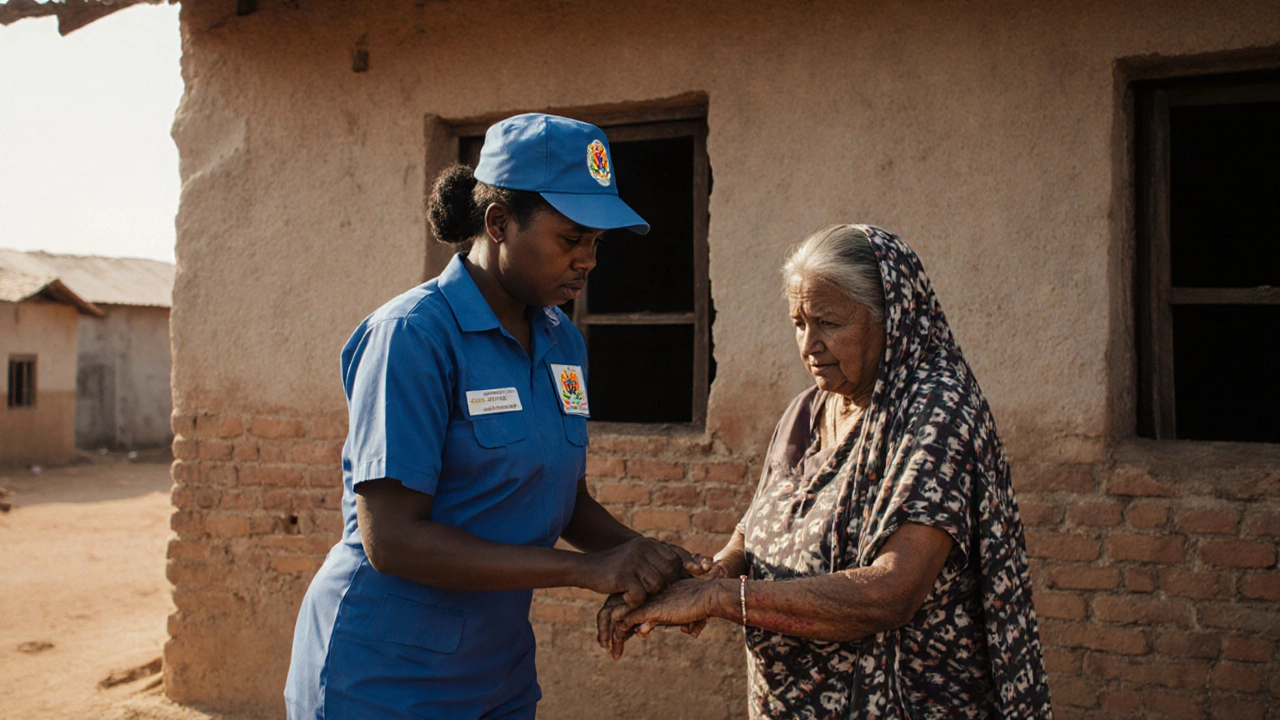Leprosy Control Program Impact Calculator
Adjust the sliders and click "Calculate Impact" to see projected results
How This Calculator Works
This tool estimates how government investments in leprosy control could reduce cases over time based on:
- Funding Level: Higher funding supports better access to MDT and health services
- Treatment Coverage: More people treated leads to faster transmission interruption
- Stigma Reduction: Lower stigma increases early detection and treatment
- Program Duration: Longer implementation allows for more significant impact
Results are estimates based on public health modeling principles.
When we talk about Leprosy is a chronic infectious disease caused by Mycobacterium leprae that primarily attacks skin, nerves, and mucous membranes. It can lead to severe disfigurement and disability if left untreated, but early diagnosis and multidrug therapy can halt its progression. Historically referred to as "the disease of the outcasts," leprosy still affects over 200,000 people worldwide, most of them in low‑ and middle‑income countries. The battle against it isn’t purely medical; it’s a classic public‑health challenge where the government role becomes decisive.
Key Takeaways
- Effective leprosy control hinges on strong government policies, financing, and coordination.
- Multidrug therapy (MDT) remains the cornerstone of treatment, but delivery depends on national health systems.
- Surveillance, community outreach, and stigma‑reduction programs are essential to break transmission cycles.
- International bodies like the World Health Organization provide guidelines, but local adaptation is critical.
- Future success will rely on sustained funding, integrated services, and innovative public‑private partnerships.
Why Government Involvement Is Crucial
National governments own the health infrastructure that reaches the most vulnerable populations. They can pass legislation that guarantees free diagnosis and treatment, allocate budget lines for leprosy programs, and enforce reporting standards. In countries where governments have taken ownership, prevalence rates have dropped dramatically. For example, India’s National Leprosy Eradication Programme (NLEP) reduced cases from over a million in the 1980s to under 150,000 by 2022.
Building Policy Frameworks and Legislation
Legislation creates the legal backbone for action. The National Leprosy Eradication Programme is a government‑led initiative that integrates leprosy services into primary health care, mandates free treatment, and sets targets for case detection is a model many countries emulate. Policies typically outline:
- Mandatory notification of every new case to a central surveillance system.
- Free provision of multidrug therapy at public clinics.
- Training modules for health workers on early detection.
- Mechanisms for inter‑sectoral collaboration, such as linking leprosy services with social welfare schemes.
When policies are backed by law, they carry weight, ensuring that leprosy control isn’t sidelined during budget cuts.

Funding and Resource Allocation
Financing is the lifeblood of any eradication effort. Governments allocate funds through national health budgets, often supplemented by donor contributions. In Brazil, for instance, the Ministry of Health earmarks around 2% of its infectious disease budget for leprosy, covering medicines, training, and outreach. Countries with dedicated budget lines can sustain drug supplies, maintain specialized clinics, and support research on vaccine candidates.
Effective budgeting also means investing in data systems. A robust Surveillance System collects real‑time case reports, maps hotspots, and guides resource deployment helps governments act swiftly, preventing outbreaks from spiraling.
Implementing Multidrug Therapy (MDT) and Health Services
The cornerstone of clinical management is Multidrug Therapy a combination of dapsone, rifampicin, and clofazimine that cures >95% of patients when taken correctly. Governments ensure MDT reaches remote clinics by:
- Negotiating bulk purchase agreements with manufacturers to lower costs.
- Integrating MDT distribution into existing drug supply chains for tuberculosis and HIV.
- Training community health workers to supervise treatment adherence.
When these steps are well‑coordinated, treatment default rates drop below 5%-a key metric for program success.
Community Engagement and Stigma Reduction
Stigma remains one of the biggest barriers. Even with free treatment, patients may avoid clinics out of fear of social exclusion. Governments launch Stigma Reduction Programs that use school curricula, mass media, and survivor testimonials to normalize the disease and promote early testing. In Nepal, a radio drama featuring a cured leprosy patient led to a 30% increase in self‑referrals within six months.
Engaging local NGOs and faith‑based groups amplifies the message, turning cultural influencers into allies.
International Collaboration and WHO Guidance
The World Health Organization provides global strategic frameworks, technical manuals, and funding mechanisms that guide national leprosy programs has set a target to eliminate leprosy as a public‑health problem (<1 case per 10,000 population) by 2030. WHO’s recommendations include:
- Standardized case definitions for uniform reporting.
- Periodic evaluation of drug resistance patterns.
- Integration of leprosy services into universal health coverage schemes.
National governments adapt these guidelines to local realities, ensuring relevance and feasibility.

Public‑Private Partnerships (PPP) - Bridging Gaps
When public resources fall short, partnerships with private labs, pharmaceutical firms, and tech startups fill the void. A notable example is the partnership in Indonesia where a biotech company supplies rapid diagnostic kits at no cost to government clinics, while the Ministry of Health covers training and distribution.
These alliances speed up innovation, lower costs, and expand reach, especially in hard‑to‑access regions.
Comparative Overview of Government Strategies
| Strategy | Typical Actions | Example Country |
|---|---|---|
| Legislative Mandates | Free treatment laws, mandatory case reporting | India (NLEP) |
| Integrated Drug Procurement | Bulk MDT purchases, shared logistics with TB/HIV | Brazil |
| Surveillance & Data Systems | Real‑time dashboards, hotspot mapping | Indonesia |
| Stigma‑Reduction Campaigns | Media outreach, school programs, survivor stories | Nepal |
| Public‑Private Partnerships | Free diagnostic kits, private lab support | Indonesia |
Future Directions and Emerging Challenges
Even with progress, new hurdles arise. Climate‑induced migration can spread cases to previously low‑incidence regions. Drug resistance, though rare, demands vigilant monitoring. Governments must therefore:
- Invest in research for next‑generation vaccines.
- Strengthen cross‑border surveillance under WHO’s International Health Regulations.
- Leverage digital health tools-mobile apps for self‑screening and tele‑consultations.
By staying adaptive, governments can keep leprosy on the back‑burner of public‑health priorities and move toward the ultimate goal of eradication.
Frequently Asked Questions
What is the current global burden of leprosy?
According to the latest WHO report (2024), there are roughly 200,000 new cases reported each year, with the highest numbers in India, Brazil, and Indonesia.
How does multidrug therapy cure leprosy?
MDT combines three antibiotics-dapsone, rifampicin, and clofazimine-that together kill the bacteria, prevent resistance, and halt nerve damage when the full course (usually 6‑12 months) is completed.
Why is government legislation important for leprosy control?
Legislation ensures free, universal access to diagnosis and treatment, mandates case reporting for surveillance, and protects patients from discrimination.
What role does the World Health Organization play?
WHO provides technical guidelines, coordinates global funding, sets elimination targets, and monitors drug resistance trends across member states.
How can stigma be reduced at the community level?
By running education campaigns, involving cured patients as ambassadors, integrating leprosy topics into school curricula, and ensuring that health services are welcoming and confidential.


Alyssa Matarum
October 9, 2025 AT 21:56Great breakdown of how government funding translates into real‑world impact. The calculator makes the numbers tangible.
Lydia Conier
October 10, 2025 AT 07:20I really appreciate the way this post pulls together policy, funding, and stigma reduction into a single narrative. It shows that leprosy control isn’t just about drugs, but also about community trust and political will. The data points on India and Brazil are especially eye‑opening – they definitly prove that targeted investment works. Also, the emphasis on surveillance systems reminded me how vital tech can be in public health. Keep the detailed examples coming, they help us see the bigger picture.
Ed Norton
October 10, 2025 AT 17:03Interesting read. Governments have a lot of leverage here. The key is consistent funding.
Karen Misakyan
October 11, 2025 AT 05:33The nexus between state policy and leprosy eradication has been substantiated by decades of epidemiological data.
Empirical evidence demonstrates that sustained fiscal allocations correlate with measurable declines in incidence.
Moreover, legislative mandates for compulsory notification engender a robust surveillance architecture.
Such frameworks facilitate the rapid identification of transmission hotspots and enable targeted interventions.
The integration of multidrug therapy into primary health services further amplifies therapeutic reach, reducing both morbidity and mortality.
Economies of scale achieved through bulk procurement of dapsone, rifampicin, and clofazimine lower per‑patient costs, thereby enhancing program sustainability.
In addition, inter‑sectoral collaboration, wherein health ministries coordinate with social welfare agencies, mitigates the socioeconomic determinants of disease propagation.
Stigma reduction initiatives, when incorporated into educational curricula and mass media campaigns, have empirically improved health‑seeking behaviors.
The case study of Nepal's radio drama exemplifies how culturally resonant messaging can precipitate a substantial increase in self‑referrals.
Parallelly, the Brazilian model illustrates that earmarking a fixed percentage of the infectious disease budget yields consistent drug supply chains.
It is imperative that governments maintain transparent budgeting processes to ensure accountability and public trust.
Robust data management systems, employing real‑time analytics, are indispensable for monitoring program efficacy and guiding resource reallocation.
International guidelines, such as those promulgated by the World Health Organization, provide a strategic scaffold that national programs may adapt to local contexts.
Nevertheless, the heterogeneity of health infrastructure across nations necessitates bespoke implementation strategies.
Ultimately, the convergence of political commitment, financial investment, and community engagement constitutes the cornerstone of leprosy eradication efforts.
Amy Robbins
October 11, 2025 AT 11:06Oh sure, because governments always get their act together on time.
Shriniwas Kumar
October 11, 2025 AT 20:50Building on that formal analysis, the pharmacovigilance component of MDT distribution warrants particular attention. Leveraging supply‑chain optimization algorithms can minimize stock‑outs, while real‑time logistics dashboards enhance visibility across peripheral clinics. Additionally, the adoption of digital adherence monitoring-via SMS reminders or electronic pill boxes-has demonstrated a statistically significant reduction in default rates. Integrating these technological solutions within the existing public‑health infrastructure not only streamlines operations but also generates granular data for predictive modeling. Such data‑driven approaches are essential for calibrating funding allocations to maximize cost‑effectiveness.
Jennifer Haupt
October 12, 2025 AT 06:33Your observation about community trust resonates deeply; without it, even the most well‑funded programs falter. When patients perceive health workers as allies rather than authorities, they are more likely to present early for diagnosis. This dynamic underscores the importance of capacity‑building workshops that emphasize culturally sensitive communication. Moreover, integrating former patients as peer educators can bridge the trust gap and demystify treatment protocols. The combination of financial investment and sociocultural alignment creates a synergistic effect that accelerates case detection.
Brian Johnson
October 12, 2025 AT 13:30I hear you, and it’s refreshing to see that human element highlighted. From my experience, the presence of empathetic counselors in clinics makes a palpable difference in patient adherence. Simple gestures-like explaining side effects in plain language-often prevent dropout. It’s a reminder that policy and money are only part of the equation; the personal touch matters just as much.
Jessica Haggard
October 12, 2025 AT 23:13The assertive stance on allocating a dedicated budget slice is spot‑on; it sends a clear signal to stakeholders that leprosy control is not a peripheral issue. Such fiscal commitment also empowers local health departments to plan long‑term interventions without constantly scrambling for ad‑hoc funds.
Alan Clark
October 13, 2025 AT 06:10Totally agree, its like when you set aside a specific budget you dont have to keep begginning a new grant each year. Consistency is key for any public health fight.
Mark Anderson
October 13, 2025 AT 15:53Wow, love the vivid description of integrating leprosy services into existing TB and HIV programs-it's like weaving a safety net that catches everyone. The creative use of "colorful" outreach, from street art to pop‑culture references, can make the message stick in ways traditional pamphlets never could.
Shouvik Mukherjee
October 13, 2025 AT 22:50I appreciate your enthusiasm for innovative outreach. While colorful campaigns are engaging, ensuring they are inclusive and accessible remains essential. A balanced approach that blends creativity with evidence‑based messaging will likely yield the best outcomes.
Karen Wolsey
October 14, 2025 AT 03:00Sure, because tossing a few dollars at the problem will magically erase centuries of stigma-realistic optimism, anyone?